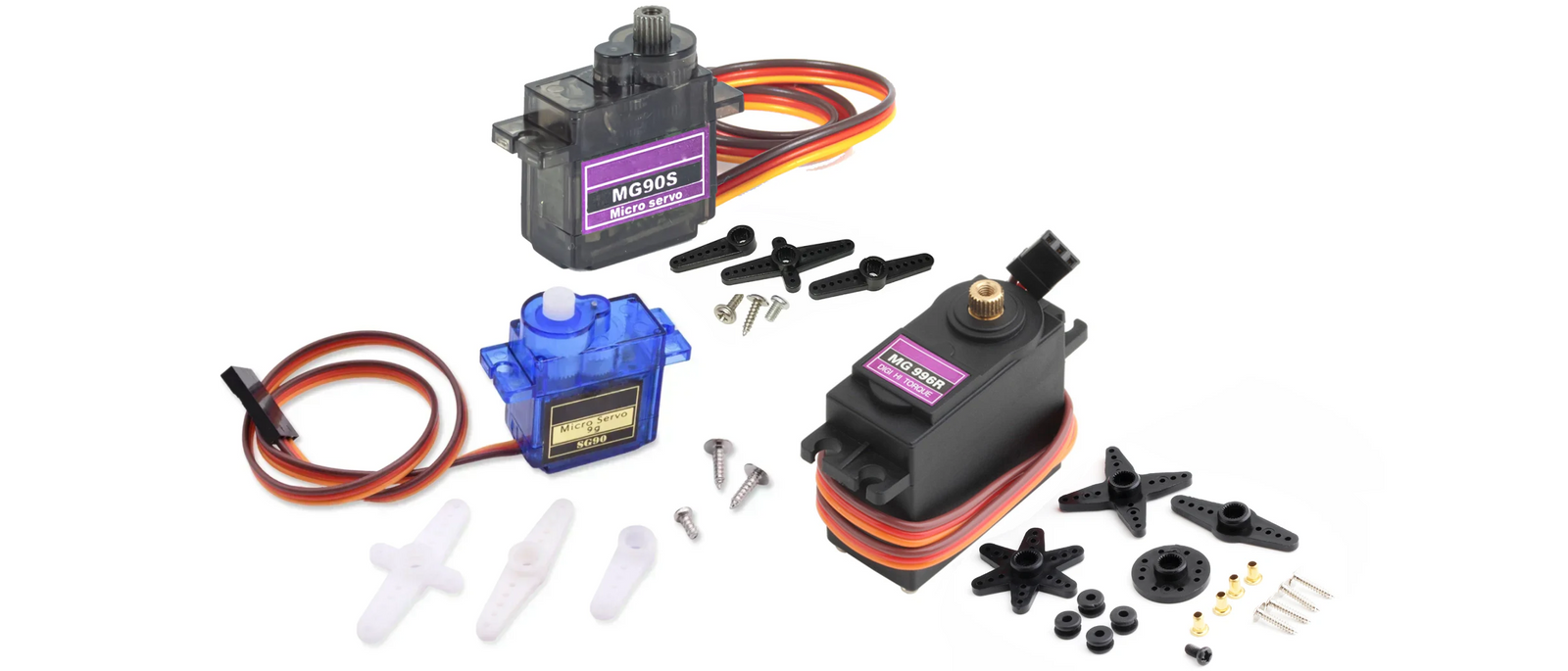A Comprehensive Guide for Hobbyists and Makers Using Servos
Servo motors are a staple in the world of electronics, robotics, and RC cars, offering precise control of angular movement. Among the most popular servos for hobbyists and makers are the SG90, MG90S, and MG996R. These small but powerful devices are often connected to development boards like Arduino, Raspberry Pi, or Raspberry Pi Pico, and are also commonly used in remote-controlled (RC) cars. In this blog post, we'll dive into the features of these three servos, their typical applications, and some tips for using them effectively.
What Are Servo Motors?
Servo motors are a type of motor that allows precise control of angular position, speed, and torque. Unlike regular DC motors, servos are designed to move to a specific position based on a control signal, making them ideal for tasks like controlling the steering mechanism in an RC car or adjusting the angle of a robotic arm.
SG90 Servo: The Classic Entry-Level Servo
The SG90 is one of the most popular and widely used servos among hobbyists.
Here's why:

- Compact and Lightweight: With dimensions of about 23 x 12 x 29 mm and a weight of approximately 9 grams, the SG90 is perfect for projects where space and weight are considerations.
- Plastic Gears: It uses plastic gears, which are lighter and more economical but can be prone to wear over time.
- Torque and Speed: It provides about 1.5 kg-cm of torque and has a typical speed of 0.1 seconds per 60 degrees at 4.8V.
- Common Applications: The SG90 is ideal for small robotics projects, miniature models, and lightweight RC vehicles.
MG90S Servo: The Metal-Gear Upgrade
The MG90S is a step up from the SG90, offering similar size and speed but with added durability:

- Metal Gears: The most significant upgrade is the use of metal gears, which are more robust and can handle higher loads without wearing out as quickly as plastic gears.
- Torque and Speed: It offers slightly more torque (about 2 kg-cm) and has a similar speed of 0.1 seconds per 60 degrees.
- Durability: Because of its metal gears, the MG90S is more durable and can withstand rougher conditions, making it suitable for RC cars and small drones.
MG996R Servo: The Heavy-Duty Option
For projects requiring more torque and robustness, the MG996R is the servo of choice:

- Increased Torque: The MG996R offers significantly higher torque (around 10 kg-cm), making it suitable for heavier loads and larger projects.
- Metal Gears: It features metal gears for enhanced durability and robustness.
- Size and Weight: It's larger and heavier than the SG90 and MG90S, measuring approximately 40.7 x 19.7 x 42.9 mm and weighing about 55 grams.
- Common Applications: This servo is ideal for larger RC vehicles, heavy-duty robotic arms, and other applications where strength is a priority.
Connecting Servos to Arduino and Raspberry Pi
Most hobbyists connect servos to development boards like Arduino or Raspberry Pi. Here's a basic overview of how to do it:
- Arduino: Servos can be controlled with Arduino's Servo library. Simply connect the servo's signal wire to one of Arduino's PWM-capable pins, and power it with a suitable power source (usually 5V).
- Raspberry Pi/Pico: To control servos with a Raspberry Pi, use PWM to send control signals to the servo. Libraries like gpiozero or RPi.GPIO can help manage PWM signals. Keep in mind that Raspberry Pi operates at 3.3V logic, so you may need a level shifter for 5V servos.
Tips for Using Servos
- Power Supply: Ensure that your power supply can handle the current draw of the servo(s). High-torque servos like the MG996R can draw significant current.
- Signal Stability: Use PWM signals with a stable frequency to control the servo's position accurately.
- Mechanical Stress: Avoid placing excessive mechanical stress on servos to prolong their lifespan.
- Calibration: Calibrate your servos to ensure they move to the desired positions accurately.
Conclusion
The SG90, MG90S, and MG996R servos offer a range of options for hobbyists and makers, from lightweight and compact to heavy-duty and high-torque. Depending on your project's requirements, you can choose the servo that best fits your needs. Whether you're building an RC car, a robotic arm, or another project that requires precise angular movement, these servos are excellent tools to have in your toolkit.


1 comment
sir i making small robot my requerment parts servo motor andsmall lcd 3.5 inch 7 inchservo motor sg90/fs90for tiny gestures bigger mg99rif torque is needed speech voice pythpon library ultrasinic sensor usbpower bank for raspbpi4 software logic